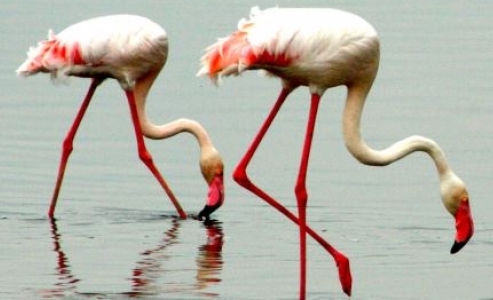Lake Manyara National Park
LAKE MANYARA NATIONAL PARK
VEGETATION CLIMATE
Due to the variety of habitats the park is able to support both large numbers and a great variety of animal and bird species. there are numerous different tree types in the park, including flat topped acacia (umbrella trees) sausage trees, doum palms, baobabs, and yellow fever trees. The long dry season lasts from June to September and the short one from January to February. Manyara is a soda lake, which shrinks considerably during the dry season, however the park usually has plenty of water throughout the year due to the fresh water springs and streams that flow from the escarpment.
ANIMALS
The park is most famous for its elephant and tree climbing lions although you are also likely to see large herds of cape buffalo, pods of hippo,small herds of impala, waterbuck, giraffe and zebra along with warthog families and reedbuck. Troops of baboons and vervet monkeys live in the forest and open areas whilst blue monkeys live only in the forest. monitor lizards can often be spotted sunning themselves on the riverbanks. Familys of mongeese, who tend to live in old termite mounds, are often seen foraging for food.
ELEPHANTS
They are plentiful in the park, found in matriarchal herds. Due to the thick vegetation it is not always easy to spot them but you should see elephants whilst in the park.
TREE CLIMBING LIONS
Are famous in the park, though the reasons they do this are unclear. Various theories exist to explain their behaviour of resting up in the trees. Some say it is to keep clear of the elephants or because they are not pestered as much by flies and ticks. Others believe that it is cooler up there than on the ground. The truth probably lies somewhere between all these theories. Whichever is correct, the lions have many favourite trees where they like to lounge, rest or sleep. They particularly like umbrella trees.
BIRDLIFE
Over 380 species of birds have been recorded in the park over the years, including many migrant species. Greater and lesser flamingo are often seen in large numbers on this soda lake, particularly thousands and thousands of lesser flamingo. On the lakeshore many types of heron-(grey-black headed), egret-(cattle-white), stork-(marabou-saddle billed- yellow billed), geese-(spur winged-Egyptian). Plover-(spurwing-crowned-blacksmith), ibis-(sacred-glossy-hadada), as well as many types of duck can be seen. Also one can see the African spoonbill, white and pink backed pelican, avocets, kingfishers, hammmerkop, cormorants, fish eagle, and the jacana. inland the large ground hornbill and other types of hornbill can be seen.
MTO WA MBU
Outside the park lies the villlage of Mto Wa Mbu, which means “mosquito creek”. this is a major stop off point for people going on safari to the Serengeti, Lake Manyara, and Ngorongoro Crater. Here is a large and thriving craft market where one can buy souvenirs. You should however bargain very hard and not accept the first price offered.
RECENT POSTS
Ngorongoro Crater
Serengeti National Park
Serengeti National Park OTHER NATIONAL PARKS ✓ Mount Kilimanjaro ✓ Serengeti National Park ✓ Ngorongoro Crater ✓ Lake Manyara National Park ✓ Tarangire National Park ✓ Zanzibar Island ✓ Arusha National Park BASE CAMP SAFARIS ✓ Luxury Lodge Safaris ✓ Luxury Tent...



